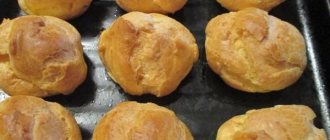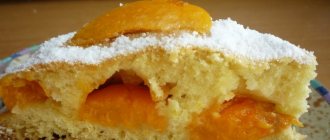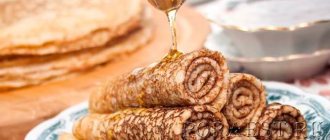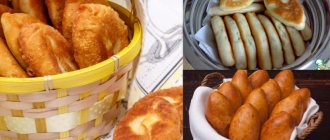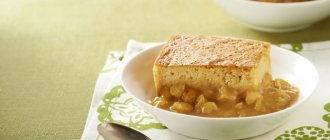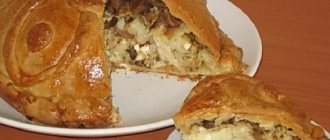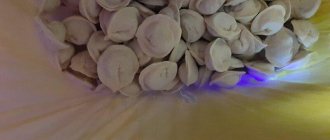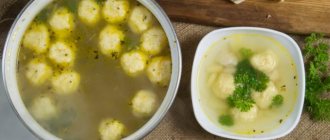Master class: preparing eclairs and profiteroles
Eclairs and profiteroles, which came to us from French cuisine, can now be found in every cafe. The choux pastry from which they are made is considered very difficult to prepare, so not all housewives decide to prepare eclairs and profiteroles at home. In fact, preparing these desserts is not so difficult if you know some secrets. Having mastered kneading choux pastry, you will learn how to make cakes with different fillings, surprising your loved ones, friends and guests. It is no coincidence that French confectioners believe that a cook who has learned to make eclairs and profiteroles has received initiation into a master of confectionery art.
What is the difference between profiteroles and eclairs
The similarity between the two types of confectionery is that they are made from choux pastry, which develops voids during baking. In other respects, they differ from each other - for example, profiteroles were invented before eclairs. These small round buns can be either a snack or a dessert, depending on whether they are filled with a sweet or savory filling. However, profiteroles are served without filling with soups and broths instead of bread. The word “profiteroles” translated from French means “benefit”, since these buns increase in size several times in the oven. The benefit is obvious - there is little dough, but there is a lot of baked goods. In other words, from a small amount of dough you can get a lot of fluffy, mouth-watering profiteroles.
Eclairs have an oblong shape, are always made with a sweet filling, and the top of the cakes is covered with icing or sprinkled with powdered sugar. “Eclair” means “lightning,” probably because the cakes instantly disappear from the table, they are so delicious.
What to cook from choux pastry?
A variety of products are prepared from choux pastry.
Turn choux pastry into treats with equally whimsical names: profiteroles, eclairs or puffballs. Once the choux pastry dough is prepared, it needs to be piped onto a baking sheet and baked to create a variety of baked goods. Choux pastry contains quite a lot of moisture, and when it goes into the hot oven, the moisture quickly evaporates, creating steam and puffing up the dough mass, creating a vessel for filling with whipped cream, pastry cream, chocolate ganache, or any filling you desire!
What is choux pastry
If the choux pastry is prepared according to all the rules, the eclairs turn out tender, fluffy and empty inside. This is the main secret, by understanding which you will learn how to make delicious eclairs. The dough contains butter, salt, water, flour and eggs, while instead of water you can use milk to get softer products; sugar is not present in all recipes. The uniqueness of choux pastry lies in the fact that the liquid in it evaporates in the oven, but thanks to the crust, the steam remains inside and puts pressure on the walls of the cakes, causing them to increase in size. The cooking technology is simple - water mixed with salt and butter is brought to a boil, the heat is reduced, and flour is added to the liquid. When the dough is removed from the stove and cooled, eggs are introduced into it one at a time. At the same time, the mass is whipped with a blender, and then the dough is laid out on a baking sheet using an attachment or spoon.
Culinary Basics: Choux Dough
Choux pastry - the basis for eclairs, profiteroles, shou, gougères and a number of other baked goods - is prepared from the most ordinary ingredients - water and/or milk, butter and eggs. But despite its simplicity, it raises a number of questions for many of those who encounter it for the first time.
Let's clear up some slippery and mysterious points in this short post.
INGREDIENTS
As with any other dough, in choux pastry a lot depends on the ingredients and how they are processed. Let's go through them in order.
Liquid
The liquid base of the choux pastry can be water, milk, or a combination of both. These options give different results. If the choux pastry is prepared with milk, then the products will brown in the oven faster than they will be completely baked inside and become crispy. At the same time, such baked goods are more tender and rich in taste due to milk protein and other substances contained in milk.
When we bake choux pastry prepared in water, for the best result it makes sense to play with the temperature in the oven: start with a higher heat so that the products puff up and brown a little, and then bring them to readiness at a lower temperature so that the inside dries out and the outer one is not burnt.
Flour
Here we come to the favorite question of many - why the dough turns out liquid and the profiteroles spread on the baking sheet. Flour - or rather, its absorbent ability - plays almost the main role here.
The more liquid the flour can absorb, the thicker the dough will be. This ability is influenced by two factors - flour moisture content and gluten content. If the moisture content of flour depends primarily on storage conditions (in the manufacturer’s warehouse, in a store, at your home) and can vary from pack to pack even within the same brand at one flour mill, then the gluten content is a constant value indicated on the packaging .
Flour with a higher gluten content absorbs more liquid and allows you to use more eggs, which has the best effect on the finished baked goods. Plus, due to the higher protein content, the dough becomes more elastic, which is also a plus.
From all of the above, we conclude: the ideal option for choux pastry is bread flour (gluten 12-13%). But you can also work with other flours and achieve quite decent results.
Oil
There are no special pitfalls here. The oil must be fresh, the fat content must be 72% or higher. Salted butter is quite suitable for choux pastry - especially if you are baking profiteroles or gougères.
Eggs
Here, too, everything is simple - we take a high-quality fresh product. The only thing that can play a trick on you is the size of the eggs. If eggs are added in excess, the dough will not be thick enough. To avoid such an incident, it is important to add the eggs one at a time, mixing well after each one. It’s better to beat the last egg with a fork and add it in parts, carefully monitoring the consistency of the dough.
TECHNOLOGY
- Mix the liquid with fat, salt and sugar (if spices are used, they are added at the same stage), put on the stove and bring to a boil and the fat dissolves.
- Without removing the saucepan from the heat, add flour - all at once! No incremental additions. Stir thoroughly to avoid the formation of lumps. Cook, stirring constantly, until the dough comes together in one lump and does not lag behind the bottom and sides of the saucepan. If the dough turns out to be too soft (see the point about flour), stir it over the heat a little longer so that it dries and becomes denser. Kneading the dough thoroughly and vigorously at this stage will further enhance its absorptive capacity when eggs are added. And this, as we already know, is a big plus for the quality of finished products.
- Transfer the brewed mixture into a mixer bowl and knead for literally 30 seconds to allow the dough to cool slightly.
- Add the eggs one at a time, mixing thoroughly after each. The dough should be soft, homogeneous, with a characteristic shine. And, of course, it should be quite thick - when jigging with a shaped nozzle, the relief should not blur.
Specific proportions of ingredients are indicated in recipes.
Subtleties of preparing choux pastry
How to prepare eclairs and profiteroles at home? Let's talk about a few secrets of French confectioners.
Secret 1. Sift the flour thoroughly. If the dough is uneven, the eclairs will not turn out. Some housewives sift the flour twice, and before the second sifting they mix it with salt. Add flour to the dough all at once, not in parts.
Secret 2. The eggs must be at room temperature, that is, they should be removed from the refrigerator about 3 hours before preparing the dough. If you add cold eggs to the dough, it will be very heavy and the eclairs may not rise.
Secret 3. Before adding eggs, the dough needs to be cooled slightly. Eggs are added gradually. After adding each egg, mix the mixture well and only then add the next one. When doing this, you need to keep an eye on the consistency of the dough, and if you notice that it is becoming very runny, stop - after all, the texture of the dough depends on the quality of the ingredients, and it is quite possible that you will need fewer or more eggs than the recipe calls for. Sometimes you can trust your intuition, without forgetting, of course, common sense. Remember that too thin a dough will quickly settle in the oven, while a thick dough may not rise at all.
Secret 4. Do not melt the butter separately, as it should melt gradually as the water boils.
Secret 5. Do not increase or decrease the amount of ingredients, strictly follow the recipe (this does not apply to eggs) and do not leave the dough, distracted by other matters. The process must be completed to the end, otherwise eclairs or profiteroles will not turn out.
Secret 6. Confectioners have different attitudes towards mixers and blenders. Many of them believe that choux pastry, whipped using kitchen appliances, turns out to be too liquid and the cakes do not hold their shape. The best option is to beat the choux pastry with a whisk, trying to knead it very quickly while it is still warm. You can knead the dough in a mixer using special attachments.
Secret 7. The consistency of the dough is very important - it should not be thick and not liquid. Ideally, the choux pastry will stretch out with a spoon, but at the same time retain its shape without spreading on the baking sheet.
Secret 8. Cakes need to be baked while the dough is warm. The cooled dough already disrupts the recipe, and in this case the result may not turn out as intended.
Secret 9. It is best to plant eclairs or profiteroles from a pastry bag - this way they turn out more impressive and even. The distance between the cakes should be approximately 7 cm, as they will rise and increase in size.
Secret 10. First bake the eclairs at 220°C for 10-20 minutes until they rise. Then reduce the heat to 190°C and bake slowly until the cakes are browned. Never open the oven while baking, otherwise the eclairs and profiteroles will turn into flat cakes. How can you tell if your cakes are ready without looking in the oven? If there are no bubbles in the cracks on the surface of the dough, and the eclairs themselves have acquired a golden color, you can turn off the oven.
Secret 11. It is better not to immediately remove the finished eclairs from the oven - let them stand for an hour and rest after baking.
Secret 12. Eclairs and profiteroles are filled with filling in two ways. You can cut them in half, fill them with cream, and then cover them with the top half of the cake. A more masterful filling is to make a small hole in the bun on one or both sides and squeeze the cream out of a pastry bag.
Secret 13. Cover the cakes with chocolate, sugar or lemon glaze. Eclairs will look more impressive, and their taste will sparkle with new shades.
Step-by-step recipe for profiteroles
If you want to learn how to make homemade profiteroles, a recipe with step-by-step instructions will be very useful to you. Prepare the necessary products in advance: 250 ml of water, ⅓ tsp. salt, 75 g butter, 150 g flour, 3 large eggs, 1 egg white.
To prepare chocolate cream you will need 200 g of butter, ½ can of condensed milk, 3 tbsp. l. cocoa, powdered sugar for dusting.
So, let's learn how to cook profiteroles step by step.
Place a saucepan on the fire with water, salt, butter, cut into pieces, and heat.
When the water boils, the butter should already have melted. Add all the flour to the water at once and very quickly, in 1-2 minutes, knead the dough with a wooden spatula.
You should get a big beautiful bun. Remove the pan from the heat and let the dough cool.
Add one egg and mix vigorously. The dough will start to separate, but you need to get it smooth again.
Add the second egg, continuing to stir and beat the dough. Do the same with the third egg.
If desired, add one egg white to the dough and beat well again. This is done so that the profiteroles rise well in the oven.
Using a pastry bag, pipe balls onto a greased baking sheet, spaced far apart.
Bake the profiteroles for 20–35 minutes in an oven preheated to 180–220 °C, and leave them for half an hour to an hour.
While the profiteroles are in the oven, prepare the cream. Combine soft butter with condensed milk and beat until smooth.
Add cocoa to the cream and beat again. If the dessert is intended for adults, you can pour 1 tbsp into the cream. l. aromatic alcohol - cognac or liqueur.
Cut off the tops of the buns, fill them with cream, return the “hats” to their place, place the cakes on a plate and sprinkle with powdered sugar.
Currant custard with Chantilly cream
Sometimes the custard itself becomes the basis for the dessert. In this dessert it is complemented by French Chantilly - sweet whipped cream.
Currant custard with Chantilly cream 6 servings, preparation: 35 min. + 2 h What you need:
- 200 g black currants
- zest of 2 lemons
- 100 ml lemon juice
- 250 g sugar
- 5 large eggs C0
- 200 g butter 82.5% fat
- mint for decoration
For the Chantilly cream:
- 400 ml whipping cream
- 40 g powdered sugar
- 1 vanilla pod
What to do: 1. For Chantilly, cut the vanilla pod in half lengthwise, scrape out the seeds with a knife, mix with 100 ml of cream and heat without boiling. Cool, mix with the remaining cream, refrigerate for at least 2 hours. 2. For the cream, chop the currants with a blender, rub through a sieve to get rid of any remaining skin. 3. Beat eggs with sugar, lemon zest and juice until completely smooth, place in a saucepan with a thick bottom. Heat over medium heat, stirring and not letting it cook to the bottom, 12–15 minutes. The cream should thicken. Remove from heat, stir in currant puree and cool. 4. Bring the butter to room temperature, beat with a mixer until fluffy. Gently fold in the custard, stirring with a spatula from bottom to top. Place in bowls or glasses, refrigerate for at least 2 hours. 5. Whip cold vanilla cream into a stable foam, gradually adding powdered sugar. Spread the resulting cream over the currant cream and serve immediately, garnished with mint.
Fillings for homemade profiteroles
Sweet fillings are usually prepared according to eclair cream recipes; they can be chocolate, cream, butter, custard, curd, protein, fruit, berries or ice cream. How to make snack profiteroles at home, which the French use for all kinds of buffets?
Any salad is suitable for this, the main thing is to chop it finely, but you should not fill the profiteroles with salads in advance, otherwise the buns will become soggy. It's better to do this just before serving. Perfect fillings include crab salad with mayonnaise, Olivier salad, potato salad with spices, cream cheese with lightly salted fish and herbs, Philadelphia cheese with lemon, curd cheese with garlic, beans with vegetables, meat pate, red caviar, fried mushrooms, beet salad. with prunes and nuts. Profiteroles can be combined with any product, and here you can use all your imagination.
Sweet creams for eclairs and profiteroles
The simplest creams are boiled condensed milk and whipped cream, since they do not need to be cooked. If you have time, try making curd, custard or coffee-nut cream - it's very tasty.
Curd cream. Whip 100 ml of 33% fat cream until fluffy foam and mix it with 60 g of powdered sugar. Separately, beat 200 g of full-fat cottage cheese in a blender and also mix it with 60 g of powdered sugar. Combine cream with cottage cheese and fill eclairs.
Classic custard. Boil 500 ml of milk. Mix 1 cup sugar, 2 tbsp. in a thick-bottomed bowl. l. flour and 1 egg, grind the mass well and gradually pour milk into it in small portions, whisking well. Place the cream on the stove over low heat and, stirring continuously, bring it not to a boil, but to a simmer. Flavor the cream with vanilla, lemon zest, cognac or spices, and when it has cooled, mix with 200 g of butter.
Coffee-nut cream. Whip 200 g of heavy cream with 100 g of sugar and 3 tsp. instant coffee in powder form. Grind 50 g of any nuts in a blender, combine with cream and beat again. The cream with pistachios and pine nuts is especially delicious.
Selection of ingredients for choux pastry
To make it, you need eggs, all-purpose flour, salt and water or milk. Whether you use milk or water ultimately depends on what you have on hand. The milk adds extra sugar and protein to the dough, which breaks down when baked to create a beautiful golden brown crust. On the other hand, water creates a lighter choux pastry with a slightly crispier crust. You can also use half water and half milk if you want to try the benefits of both ingredients.
Making choux pastry
If you use milk, heat it slowly to avoid burning yourself. Otherwise, it is important to remember to stir vigorously until a sticky ball of dough forms around the spoon. Pour it into a mixer and stir slowly for about a minute to cool the mixture. Then continue to slowly pour in the eggs and increase the speed to medium until the custard mixture emulsifies. The finished choux pastry should be smooth, shiny, but not too hard. Since eggs vary in weight, you may need to add one or two extra eggs to achieve the desired consistency. Keep a couple more on hand, in this case adding them one at a time until the dough is slightly loosened. You'll know everything is fine when you dip the paddle into the dough, pull it out, and some of the choux pastry sticks to the paddle and hangs off it.
Glaze for eclairs
Eclairs and profiteroles are delicious on their own, but if you cover them with glaze on top, they will look more impressive. The glaze can be sprinkled with poppy seeds, ground nuts, coconut, sesame seeds or waffle crumbs.
For chocolate glaze, mix 100 g of chocolate and 50 g of cream, heat the mixture in a water bath until the chocolate melts, and immediately cover the cakes. Lemon glaze is prepared from 100 g of powdered sugar and 2 tbsp. l. lemon juice - it also needs to be used immediately. The icing sugar is very tasty, which is made from 120 g of powdered sugar and 1½ tbsp. l. milk - the mass is heated in a water bath and 1 tbsp is gradually added. l. lemon juice, from which the glaze will immediately begin to thicken.
You will find recipes for homemade profiteroles and eclairs on the “Eat at Home!” website. Having prepared cakes according to our recipes at least once, you will understand why this dessert is called royal in France. Delicious cakes will be appreciated by your children and other household members, so you will have to cook them more often. Having mastered the intricacies of preparing choux pastry, you can easily bake any eclairs and profiteroles. Don't forget to share your finds with us!
